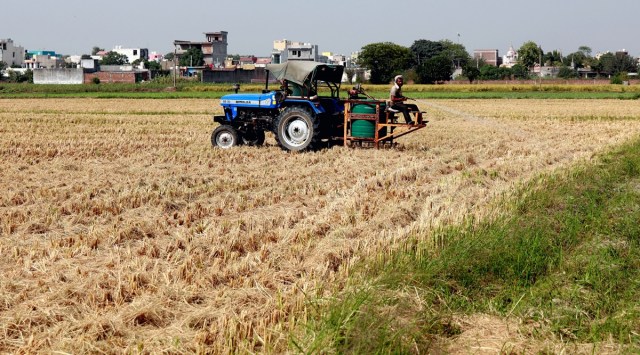Farm fires: Does the biodecomposer help? Here is what farmers say
A total of 880 applications from farmers have been received so far, for a total area of 7,159 acres.
 The exercise of spraying the bio-decomposer began Friday. (Express Photo by Amit Mehra)
The exercise of spraying the bio-decomposer began Friday. (Express Photo by Amit Mehra) As Delhi began the exercise of spraying a bio-decomposer for the fourth consecutive year on Friday, can the microbial solution help deal with the stubble-burning problem? It’s all in the timing, say farmers.
Stubble burning in Delhi itself does not contribute much to its pollution levels — the fire count so far this year is two, according to Indian Agricultural Research Institute (IARI) data. Last year, from September 15 to November 30, there were 10 such instances, four in 2021, and nine in 2020.
The solution, prepared from fungi by the IARI, is expected to help decompose paddy straw left behind on the field after harvest — it is to be sprayed on the field post-harvest, ploughed to mix the straw into the soil, and lightly irrigated. It can then take 20-25 days for stubble to decompose, said Dr Rajesh Kumar at the Microbiology Division, IARI.
In North Delhi’s Tigipur, where spraying began Friday, harvesting and preparing the field for the next crop was already complete in several fields. Vikrant (43), a farmer, who cultivates 5 bighas of land he takes on lease from the owner, said he got the solution sprayed once before, but didn’t have time this year.
“The variety of paddy we grew was harvested a few weeks back. We can’t leave the land fallow till spraying begins. Once the crop is harvested using a combine harvester, stubble is ploughed back into the soil. This consumes more diesel, and there might be some benefit in getting the decomposer sprayed, but we couldn’t wait. Many here have already completed the harvest,” said Vikrant, who was preparing land for a coriander crop.
Another farmer Naveen, who cultivates 60 to 70 acres, and harvested the crop 15 to 20 days ago, agrees that the spraying process will have to begin a month earlier than it did this year for it to be of use to more farmers.
For farmers who grow crops like fenugreek between paddy and wheat crops, the decomposer is not of much use, considering the time it takes to work, said Situ Rana, who has three acres of land and has never tried the decomposer.
A total of 880 applications from farmers have been received so far, for a total area of 7,159 acres. This is likely to reduce, officials said, as some farmers may not get it sprayed if the time of spraying does not match that of harvest.
Even if the decomposer is not used, instances of burning are low, said Dhiraj Singh, Agriculture Extension Officer, North Delhi. “This is for a few reasons — with more machines now, the crop is cut close to the ground, leaving little straw behind. This is ploughed back into the soil. If labour is available and harvest is done by hand, the straw is sold for packaging at the market, or to be turned into fertiliser,” he said.
Rainfall that extended into October last year may have delayed the harvest, but this year, with little rain in September and October so far, temperatures have been high, he added.
Like last year, the government targeted 5,000 acres for spraying. This may only be a part of the area under paddy cultivation in Delhi — in 2021-22, the total area under paddy in Delhi was 6,171 hectares, as per the Economic Survey of Delhi. The target was not met last year, with 4400 acres eventually being covered.
Environment Minister Gopal Rai said Friday, “Very little paddy stubble is generated in Delhi… the first year that we tried this, we prepared a solution from a capsule. It is now available in solution and powder form. Teams have conducted surveys, and farmers have filled out forms… we have given the country a new solution. In Punjab, where we have an AAP government, there have been preparations to prevent stubble burning this year.”
Rai had said last year that the solution was sprayed on around 3,000 acres in 2020, the year it was introduced, followed by around 4,000 acres in 2021.
Meanwhile, the decomposer was also sprayed on Kunal Gahlot’s 5-acre land for the first time. “Last year, we got it harvested by hand and sold the straw. This year, labour availability was low. It is important to see the time and quality of decomposition,” said the farmer.
On a neighbouring 7-acre field, the paddy crop has already been harvested and radish sown. “It was an early variety of paddy. The straw was ploughed back into the soil and took about a month for the field to be ready for the next crop. The solution too, when sprayed, may take that long. It works more like a fertiliser, rather than something that helps decompose stubble,” said Ajit Singh, a farmer.







